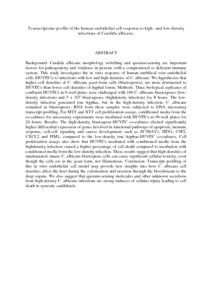Citation
Chong, Pei Pei and Rozita, Rosli and Seow, Heng Fong and Lim, Crystale Siew Ying and Tan, Hui Yin
(2010)
Transcriptome profile of the human endothelial cell response to high- and low-density infections of Candida albicans.
International Journal of Infectious Diseases, 14 (Supplement 1).
e341.
ISSN 1201-9712, ESSN: 1878-3511
Abstract
Background:
Candida albicans morphology switching and quorum-sensing are important factors for pathogenicity and virulence in persons with a compromised or deficient immune system. This study investigates the in vitro response of human umbilical vein endothelial cells (HUVECs) to infections with low and high densities of C. albicans. We hypothesize that higher cell densities of C. albicans yeast-form cells (blastospores), are more detrimental to HUVECs than lower cell densities of hyphal forms.
Methods:
Three biological replicates of confluent HUVECs in 6-well plates were challenged with 106 C. albicans blastospores (low-density infection) and 5 x 107 blastospores (highdensity infection) for 8 hours. The low-density infection generated true hyphae, but in the high-density infection, C. albicans remained as blastospores. RNA from these samples were subjected to DNA microarray transcript profiling. For MTT and XTT cell proliferation assays, conditioned media from the co-cultures for microarray experiments were incubated with HUVECs in 96-well plates for 24 hours.
Results:
The high-density blastospore-HUVEC co-cultures elicited significantly higher differential expression of genes involved in functional pathways of apoptosis, immune response, cell-cell signaling and cancer development, such as ZC3HAV1, HES1, CSF2, CXCL2 and PIM1, compared to the low-density true hyphae-HUVEC co-cultures. Cell proliferation assays also show that HUVECs incubated with conditioned media from the highdensity infection caused a higher percentage of cell death compared to incubation with conditioned media from the low-density infection. These results suggest that high densities of unattenuated, innate C. albicans blastospore cells can cause significant cellular toxicity, even though the cells are in the yeast form, not filamentous.
Conclusion:
Transcript profiling of this in vitro endothelial cell model may provide new insights into how C. albicans cell densities affect the host during the colonization and invasion through the bloodstream to the deep organs. We also suggest that quorum-sensing molecules and other unknown secretions from high-density C. albicans infections are strong inducers of cellular injury leading to cell death in systemic candidiasis.
Download File
![[img]](http://psasir.upm.edu.my/17469/1.hassmallThumbnailVersion/Transcriptome%20profile%20of%20the%20human%20endothelial%20cell%20response%20to%20high.pdf)  Preview |
|
PDF (Abstract)
Transcriptome profile of the human endothelial cell response to high.pdf
Download (85kB)
| Preview
|
|
Additional Metadata
Actions (login required)
 |
View Item |

